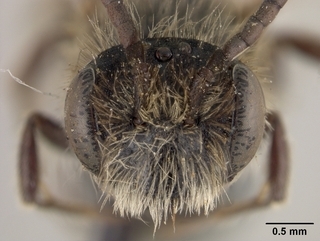
Smithsonian Institution, Entomology Department · 1
Andrena candidiformis, face |
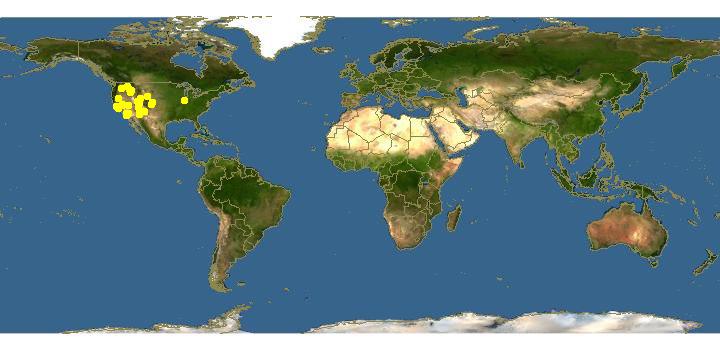
Click on map for details about points.
|
80x5 -
240x3 -
240x4 -
320x1 -
320x2 -
320x3 -
640x1 -
640x2
Set display option above.
Click on
images to enlarge. |
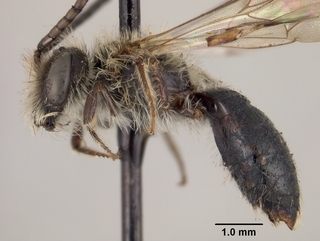
Smithsonian Institution, Entomology Department · 1
Andrena candidiformis, side |
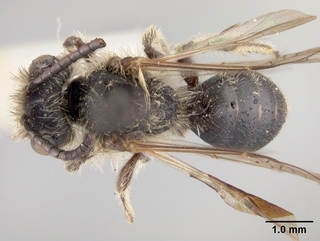
Smithsonian Institution, Entomology Department · 1
Andrena candidiformis, top |
|
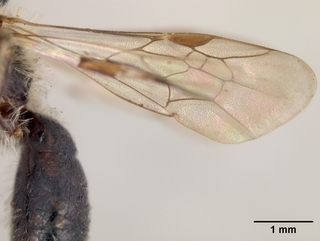
Smithsonian Institution, Entomology Department · 1
Andrena candidiformis, wing |
|
Overview |
Reprinted with permission from the University of Nebraska State Museum from:
Ribble, D. W. 1968. Revisions of two subgenera of Andrena, Micrandrena Ashmead and Derandrena new subgenus (Hymenoptera: Apoidea). Bulletin of the University of Nebraska State Museum 8: 1-124.
Please report text errors to: leah at discoverlife dot org.
Viereck and Cockerell describe the male and female of this species as different species in the same paper. Linsley (1951) is first to synonymize nigritarsis under candidiformis. Linsley cites Timberlake (in lit.) as the authority for making this synonymy. These workers are followed here and the name candidiformis is used for this species. Cockerell (1936, p. 150) and Timberlake (1951) distinguish candidiformis from semotula on two slight male color differences, which do not warrant separating the two (see Variation). Timberlake (1951) admits that semotula is only a weakly distinguishable race.
No specimen of candidiformis bears a determination label of another species, indicating the distinctness of this species. Andrena candidiformis is a large (for Micrandrena), entirely dark, western bee with a large stigma. The female has a very shiny abdominal tergum one, yellowish moss-like hairs on the dorsum of the thorax, and the hind tibia is widened somewhat and has long scopal hairs. The male can be distinguished by the long, dark, shiny antennae and a dark clypeus.
The descriptions below are based mainly on a male (Quincy, May 13, 1949, W. W. Middlekauff) and a female (Quincy, 4 mi. W., June 22, 1949, W. F. Ehrhardt) from California. A total of 509 specimens of candidiformis were examined during this study.
FEMALE. MEASUREMENTS AND RATIOS. — Length, 7.4 mm; width of mesothorax, 2.0 mm; wing length from tegula, 5.6 mm; facial length/width, 0.97; to veal length/width, 3.4.
INTEGUMENTAL COLOR. — Black to dark brown (without reflections of other colors) except: veins and pterostigma amber; tegula amber; distitarsi brown at tip; color otherwise as in piperi.
STRUCTURE. — Sculpturing in general finer over entire body than in piperi. Head otherwise as in piperi except: flagellar segment 1 noticeably shorter than 2 and 3 together; eye about four times as long as broad; maxillary palpus with segments in ratio of about 1.1:1.3:1.0:1.1:1.0:1.2; labial palpus with segments in ratio of about 1.7:1.2:1.0:1.3; labrum about two and one-half times as wide as long; labral process one-fourth as wide as and half as long as entire labrum, expanded towards base; genal area in lateral view distinctly wider than eye; vertex extending past lateral ocellus by one ocellar width; facial fovea just reaching upper eye margin.
Mesosoma as in piperi except: suture extending anteriorly from pit at base of posterior pronotal lobe reduced to a faint depression; enclosure of propodeum with reticular shagreening becoming roughened anteriorly; mesepisternum with surface more uneven than on mesoscutum.
Metasoma as in piperi except: tergum 1 with fine reticular shagreening, very shiny; pygidial plate elevated in center, edges not bent upward.
VESTITURE. — Hairs as in piperi except: most hairs with yellowish tinge; dorsum of thorax with few moss-like hairs; terga 1-4 hairs (except apical fasciae) not very plumose, abdomen not having a dusty appearance; apical fasciae white, absent on tergum 1, interrupted medially on terga 2-4.
MALE. MEASUREMENTS AND RATIOS. — Length, 5.8 mm; width of mesothorax, 1.8 mm; wing length from tegula, 5.3 mm; facial length/width, 0.96; flagellar segment 1/segment 2, 0.68.
INTEGUMENTAL COLOR. — Black to dark brown (without reflections of other colors) except: clypeus entirely dark; pterostigma and veins amber; tegula amber; distitarsi brown; color otherwise as in piperi.
STRUCTURE. — Sculpturing in general finer over entire body than in piperi. Head otherwise as in piperi except: antenna reaching abdomen; scape reaching to within one and one-half ocellar distances of medium ocellus, much shorter than flagellar segments 1-3; segment 2 half again as long as 1, not noticeably tapered; segment 3 equal in length to 2; middle segments one-third longer than broad; eye four times as long as broad in anterior view; inner eye margins slightly convergent below; malar space about eight times as wide as long; maxillary palpus with segments in ratio of about 1.2:1.2:1.1:1.2:1.0:1.2; labial palpus with segments in ratio of about 2.0:1.3:1.0:1.3; labrum two and one-half times as wide as long; labral process truncated at apex.
Mesosoma as in female except hind tibia unmodified.
Exposed metasoma as in female except: tergum 1 with coarser shagreening, not very shiny; pygidial plate absent.
Sternum 7 notched at apex, producing two truncated processes, each process bearing numerous setae (fig. 52). Sternum 8 (fig. 53) much like piperi except anterior half somewhat different in outline. Gonocoxite bent downward; apex expanded in lateral view; dorsolateral part with several setae, dorsal lobes moderate in size and length. Penis valve bent downward, apex rather narrow, rounded in lateral view, medially greatly expanded (figs. 49-51).
VESTITURE. — Hairs as in piperi except: few chocolate brown hairs on face along eyes and above antennae; apical abdominal fasciae absent on tergum 1.
VARIATION. — Cockerell (1936) and Timberlake (1951) separated semotula from candidiformis on the basis of male antennal and stigma color. The variation that they described is due to these workers having a mixture of fresh specimens (California) and specimens collected long ago (Colorado). The older specimens had faded, giving them a different appearance.
There are several differences which are considered to be due mostly to individual variation. In both sexes the apical part of the clypeus may either be smooth and very shiny between the punctures, or have fine reticular shagreening. The labral process in the male is either truncate at the apex or slightly emarginate; orientation of the specimen under the microscope may change the appearance of this character. There appears to be some variation in the width of the apex (at its widest part) of the gonocoxite.
Specimens from Arizona average a little smaller in overall size than specimens from other parts of the range.
|
|
|
Names | |
|
|
| Supported by | |
Updated: 2024-04-26 00:20:36 gmt
|